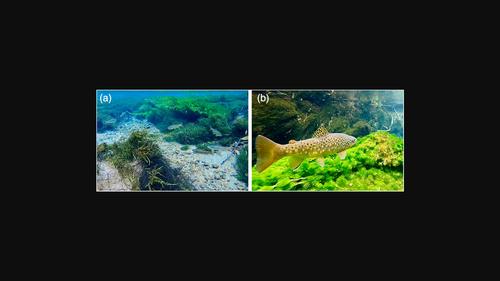当前位置:
X-MOL 学术
›
Ecol. Res.
›
论文详情
Our official English website, www.x-mol.net, welcomes your feedback! (Note: you will need to create a separate account there.)
Species-specific foraging behavior and diets of stream salmonids: An implication for negative impacts on native charr by nonnative trout in Japanese mountain streams
Ecological Research ( IF 2 ) Pub Date : 2023-12-26 , DOI: 10.1111/1440-1703.12419 Miles I. Peterson 1, 2 , Satoshi Kitano 3 , Shoichiro Yamamoto 4 , Tomohiro Kando 2 , Yoshiaki Tsuda 2
Ecological Research ( IF 2 ) Pub Date : 2023-12-26 , DOI: 10.1111/1440-1703.12419 Miles I. Peterson 1, 2 , Satoshi Kitano 3 , Shoichiro Yamamoto 4 , Tomohiro Kando 2 , Yoshiaki Tsuda 2
Affiliation

|
Salmonids have been introduced globally as a food source and recreational fishing target. In Japan, brown trout (Salmo trutta) and brook trout (Salvelinus fontinalis) were introduced in the 19th century and have since spread. In many headwater streams, native white-spotted charr (Salvelinus leucomaenis) are thought to be experiencing negative impacts from these species. The current study examined foraging behavior, microhabitat use, and diet overlap of these three species in Kamikochi, Nagano Prefecture: one of Japan's premier mountain areas. In Kamikochi, many spring-fed headwater streams are currently dominated by these invasive salmonids and white-spotted charr have declined drastically over the last half century. Underwater video analysis revealed that while total foraging rates and foraging modes were similar between the three species, brook trout and white-spotted charr foraged benthically more frequently than brown trout. Microhabitat water depth and flow velocity were similar between species, and fish size had a positive effect on water depth and flow velocity in all three species. Diet analysis indicated that brook trout and white-spotted charr diets were nearly identical, comprised primary of aquatic invertebrates, while brown trout preyed on a mix of terrestrial and aquatic invertebrates, as well as amphibians and fish. These results indicate that in Kamikochi, the decline of white-spotted charr is likely most influenced by direct competition with brook trout for prey resources. However, brown trout likely also predate on juvenile white-spotted charr, while also possibly causing a foraging niche shift of white-spotted charr, and have ecosystem-level impacts due to predation on terrestrial prey.
中文翻译:

溪流鲑鱼的物种特异性觅食行为和饮食:日本山溪中的非本地鳟鱼对本地红点鲑的负面影响
鲑鱼已被引入全球作为食物来源和休闲钓鱼目标。在日本,褐鳟鱼 ( Salmo trutta ) 和溪鳟鱼 ( Salvelinus fontinalis ) 于 19 世纪引入,并从此传播开来。在许多源头溪流中,当地的白点红点鲑(Salvelinus leucomaenis)被认为正受到这些物种的负面影响。目前的研究调查了长野县上高地(日本主要山区之一)这三个物种的觅食行为、微生境利用和饮食重叠。在上高地,许多泉水源头的溪流目前主要由这些入侵性鲑鱼控制,而白点红点鲑在过去半个世纪中急剧减少。水下视频分析显示,虽然这三个物种的总觅食率和觅食模式相似,但溪鳟和白点红点鲑在底栖觅食的频率高于褐鳟。物种之间的微生境水深和流速相似,并且鱼类的大小对所有三个物种的水深和流速都有积极影响。饮食分析表明,溪鳟和白点红点鲑的饮食几乎相同,主要由水生无脊椎动物组成,而褐鳟则捕食陆生和水生无脊椎动物,以及两栖动物和鱼类。这些结果表明,在上高地,白点红点鲑的减少可能最受与溪鳟鱼对猎物资源的直接竞争的影响。然而,褐鳟鱼也可能捕食幼年白点红点鲑,同时也可能导致白点红点鲑的觅食生态位转移,并由于捕食陆地猎物而对生态系统产生影响。
更新日期:2023-12-26
中文翻译:

溪流鲑鱼的物种特异性觅食行为和饮食:日本山溪中的非本地鳟鱼对本地红点鲑的负面影响
鲑鱼已被引入全球作为食物来源和休闲钓鱼目标。在日本,褐鳟鱼 ( Salmo trutta ) 和溪鳟鱼 ( Salvelinus fontinalis ) 于 19 世纪引入,并从此传播开来。在许多源头溪流中,当地的白点红点鲑(Salvelinus leucomaenis)被认为正受到这些物种的负面影响。目前的研究调查了长野县上高地(日本主要山区之一)这三个物种的觅食行为、微生境利用和饮食重叠。在上高地,许多泉水源头的溪流目前主要由这些入侵性鲑鱼控制,而白点红点鲑在过去半个世纪中急剧减少。水下视频分析显示,虽然这三个物种的总觅食率和觅食模式相似,但溪鳟和白点红点鲑在底栖觅食的频率高于褐鳟。物种之间的微生境水深和流速相似,并且鱼类的大小对所有三个物种的水深和流速都有积极影响。饮食分析表明,溪鳟和白点红点鲑的饮食几乎相同,主要由水生无脊椎动物组成,而褐鳟则捕食陆生和水生无脊椎动物,以及两栖动物和鱼类。这些结果表明,在上高地,白点红点鲑的减少可能最受与溪鳟鱼对猎物资源的直接竞争的影响。然而,褐鳟鱼也可能捕食幼年白点红点鲑,同时也可能导致白点红点鲑的觅食生态位转移,并由于捕食陆地猎物而对生态系统产生影响。



























 京公网安备 11010802027423号
京公网安备 11010802027423号